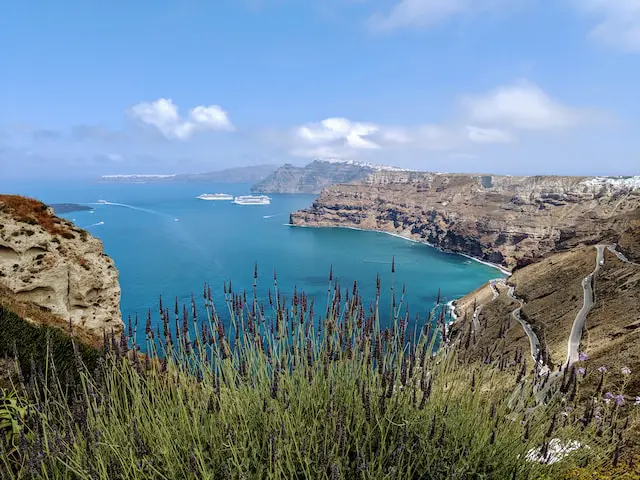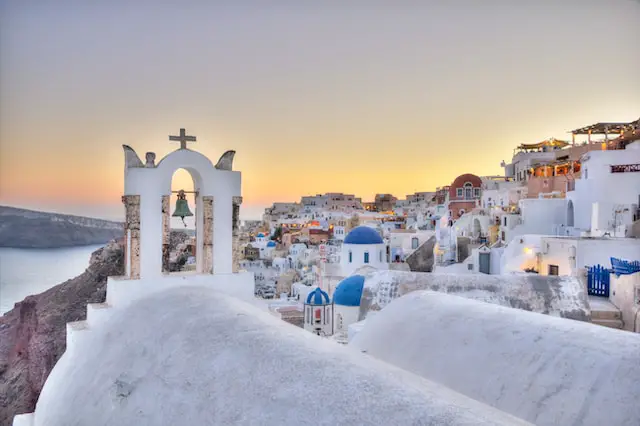Santorini, the crown jewel of Greece’s Cyclades islands, is a stunningly beautiful vacation destination that is renowned across the globe. Famous for its breath-taking sunsets, distinctive architecture, delectable cuisine, and rich history, Santorini has a magnetic allure that draws millions of tourists each year.
Santorini’s iconic image, with its hillside villages of stark white houses and deep blue domed churches, contrasting vividly against the sapphire blue Aegean Sea, is one that has become a symbol for idyllic beauty. The island’s settlements, namely Fira, Oia, Imerovigli, and Firostefani, are perched on the cliffs of a caldera—a cauldron-like feature formed by the collapse of land following a volcanic eruption. The caldera views, particularly from Oia, the island’s most northern town, are genuinely awe-inspiring.
Oia is synonymous with Santorini’s famous sunsets. As the sun begins to set, it paints the town in shades of red, pink, and orange, making it a spectacle that people from all around the world flock to see. The sunset from the Byzantine Castle ruins is particularly popular, and it’s common to see a crowd of visitors assembled there, waiting for the moment when the sun dips below the horizon, leaving behind a blanket of stars.
Fira, the capital, is equally beautiful and offers a slightly more cosmopolitan feel, with a plethora of bars, shops, and restaurants. The narrow streets, filled with white-washed buildings and blue-domed churches, are alive with the hustle and bustle of local life. The restaurants offer a gastronomic delight, with local dishes such as fava, tomatokeftedes, and the unique white eggplant, which are not only mouth-wateringly delicious but also offer a taste of Santorini’s culture.

Another settlement, Imerovigli, also referred to as the ‘balcony to the Aegean,’ is situated at the highest point of the caldera. It provides arguably the most magnificent panoramic views of the Aegean Sea and the surrounding islands. Besides its mesmerizing vistas, Imerovigli is home to Skaros Rock, a significant historical site. This rocky headland is a remnant of one of the island’s medieval capitals and offers a wonderful trekking experience.
Santorini’s dramatic topography is largely the result of one of the largest volcanic eruptions in recorded history, the Minoan eruption, which occurred around 3600 years ago. The island is still volcanically active; the two volcanic islands in the center of the caldera, Palea Kameni and Nea Kameni, are popular tourist spots. The warm waters around these islands, rich in minerals, are known for their therapeutic properties.
The island’s volcanic soil also contributes to its unique agricultural products. Santorini is known for its exceptional wines, with the Assyrtiko grape being the most famous. Wine tours are a popular activity on the island, allowing visitors to sample these distinct wines and learn about Santorini’s centuries-old winemaking traditions.
Santorini’s history is as layered as its volcanic soil. The island was the site of the prosperous Minoan settlement of Akrotiri, which was preserved under volcanic ash. Today, the archaeological site of Akrotiri offers a glimpse into this Bronze Age civilization. Another significant historical site is Ancient Thera, an antique city on a ridge of the steep, 360 m high Messavouno mountain.
Santorini’s beaches are another of its draws, with their multicolored sands a result of the island’s volcanic origin. The Red Beach, the Black Beach, and the White Beach, each named for the color of their sands and pebbles, are sights to behold. The Red Beach, surrounded by steep red cliffs and scattered with red and black volcanic rocks, offers a stark contrast to the usual golden sands found at most beaches. The Black Beaches of Kamari and Perissa, their shores covered in unique black pebbles, provide an equally distinctive beach experience, complete with crystal-clear waters that make for excellent snorkeling conditions. The White Beach, accessible only by boat or a challenging footpath, is a secluded paradise with its towering white cliffs and azure waters.
Santorini’s culture is another facet of the island that charms visitors. Despite the influx of tourism, the island retains its traditions. One can witness the vibrant Easter celebrations or the summer Panigiri festivals, where locals come together to celebrate the feast day of a saint with food, wine, music, and dancing. The island’s museums, such as the Museum of Prehistoric Thera, with its artifacts from Akrotiri, and the Maritime Museum in Oia, help preserve and share the island’s rich history and maritime traditions.

A Santorinian culinary experience is a must when visiting the island. The volcanic soil gives a unique flavor to its produce. Local dishes like fava me Koukia (mashed fava beans), Greek salad with capers, and grilled fish are a food lover’s delight. A local gastronomic gem is the Santorini tomato, or “tomataki”, as the locals call it. These tomatoes are intensely flavored, and their low water content makes them ideal for the island’s famous tomato fritters, known as tomatokeftedes. Another must-try is the island’s local cheese, Chloro, a fresh goat cheese that pairs perfectly with local wine.
Speaking of wine, a trip to a traditional winery is an enriching experience. The vineyards of Santorini, some of the oldest in the world, have a unique basket-shaped pruning system, “kouloura”, to protect the vines from strong winds and preserve moisture. This island is particularly famous for its dry white wines from the Assyrtiko grape, and the sweet, sun-dried Vinsanto, both of which offer a true taste of the Aegean.
The unique accommodations of Santorini deserve a special mention. The charming “cave houses”, originally homes for the island’s poor, have been transformed into luxury dwellings that offer stunning views of the Aegean sea. Whether staying in a high-end hotel or a traditional house, the hospitality of the Santorinians is heartwarming.
While Santorini is often associated with honeymooners and romantic getaways, its offerings are diverse enough to cater to different types of travelers. Families, history enthusiasts, nature lovers, foodies, wine connoisseurs, beach-goers, and those in search of a luxury vacation can all find what they seek on this gorgeous island.
In conclusion, Santorini, with its stunning landscapes, deep history, unique cuisine, and vibrant culture, offers an enchanting experience that leaves an indelible impression on its visitors. Its allure lies in more than just its visual appeal. The island, much like its own wines, is a complex blend of history, culture, and unique geography, which needs to be savored to be truly appreciated.







